Powerful M7.5 earthquake hits Sulawesi, major tsunami in Palu and Donggala, Indonesia
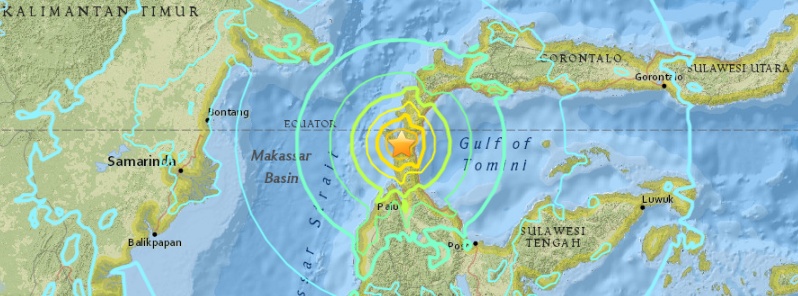
Very strong and shallow earthquake registered by the USGS as M7.5 hit Minahasa, Sulawesi, Indonesia at 10:02 UTC (18:02 WITA) on September 28, 2018. The agency is reporting a depth of 10 km (6.2 miles). BMKG is reporting M7.4 at a depth of 10 km, EMSC M7.4 at the same depth. Powerful aftershocks are shaking the region. The quake comes just 3 hours after deadly M6.1 hit the same area.
According to the USGS, the epicenter was located 44 km (34 miles) NNE of Donggala, 80 km (50 miles) N of Palu (population 282 431), and 168 km (105 miles) NW of Poso (population 47 110), Indonesia.
A tsunami warning has been issued by the BMKG. A major tsunami was reported in Palu and Donggala.
Peringatan Dini #Tsunami untuk wilayah: SULBAR, SULTENG, Gempa Mag:7.7, 28-Sep-18 17:02:44 WIB, Lok:0.18 LS, 119.85 BT (27 km TimurLaut DONGGALA-SULTENG), Kedlmn:10 Km #BMKG pic.twitter.com/NMRQm1XNOZ
— BMKG (@infoBMKG) September 28, 2018
#Peringatan dini TSUNAMI yang disebabkan oleh gempa mag:7.7, tanggal: 28-Sep-18 17:02:45 WIB, dinyatakan telah berakhir#BMKG pic.twitter.com/wNNdOe0WME
— BMKG (@infoBMKG) September 28, 2018
There are 780 000 people living within 100 km (620 miles).
Some 20 000 people are estimated to have felt severe shaking, 73 000 very strong, 604 000 strong, 1 374 000 moderate, 12 047 000 light and 9 259 000 weak.
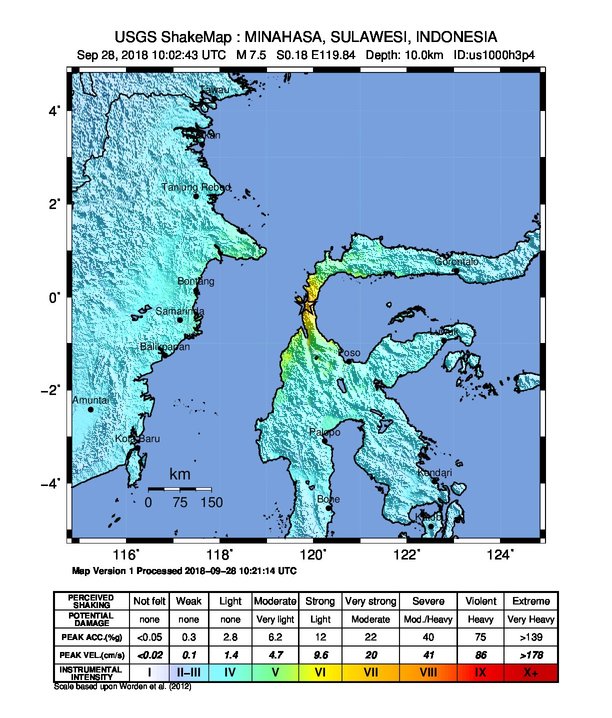
The USGS issued a yellow alert for shaking-related fatalities and economic losses. Some casualties and damage are possible and the impact should be relatively localized. Past yellow alerts have required a local or regional level response.
Overall, the population in this region resides in structures that are vulnerable to earthquake shaking, though resistant structures exist. The predominant vulnerable building types are unreinforced brick with concrete floor and precast concrete frame with wall construction.
Recent earthquakes in this area have caused secondary hazards such as tsunamis that might have contributed to losses.
Estimated population exposure to earthquake shaking
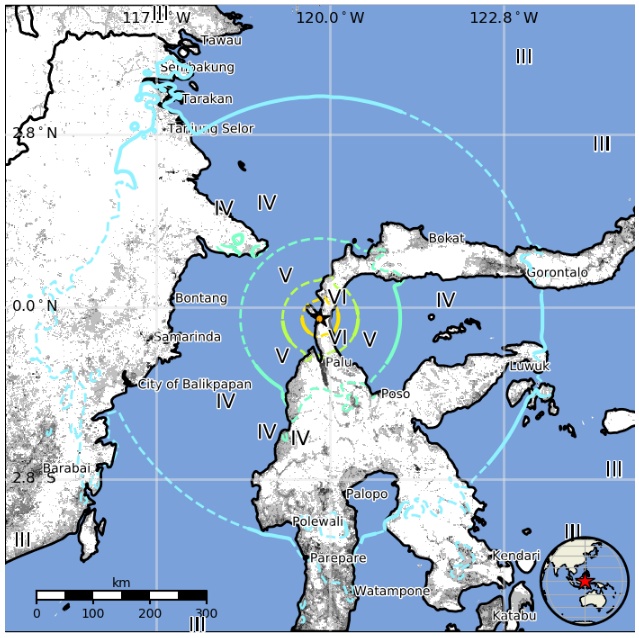
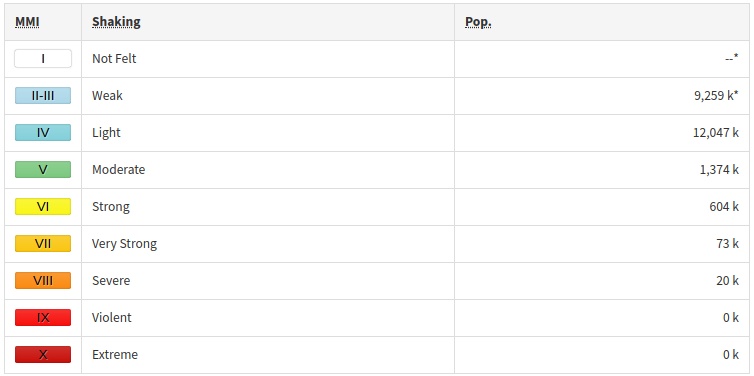
Selected cities exposed

Regional seismicity
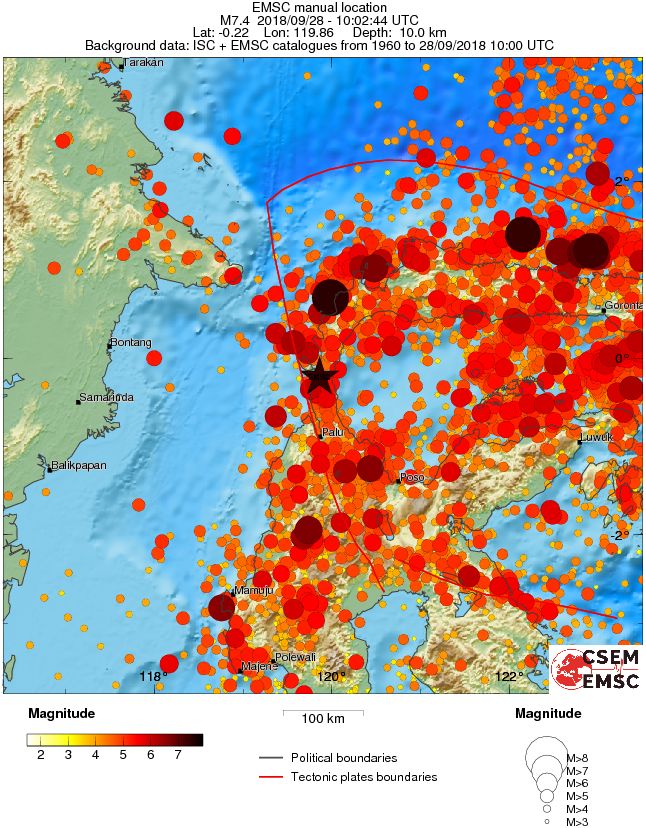
The USGS registered two M5.8 aftershocks at 10:14 and 10:25, respectively. Both at a depth of 10 km.
At 07:00 UTC today, a M6.1 earthquake hit the same region, killing at least one person and injuring 10. Dozens of homes were damaged.
1 orang meninggal dunia, 10 orang luka-luka dan puluhan rumah rusak akibat gempa dengan kekuatan magnitudo 6 mengguncang Donggala Sulawesi Tengah. Daerah yang mengalami kerusakan ada di Kec Sinreja Kab Donggala yang dekat pusat gempa. Gempa susulan masih terus terjadi. pic.twitter.com/u7d27niBYx
— Sutopo Purwo Nugroho (@Sutopo_PN) September 28, 2018
Rumah roboh dekat pusat gempa M 5.9 yang mengguncang Donggala. Beberapa rumah dilaporkan rusak. Pusat gempa di darat berasal dari sesar Palu sehingga dirasakan guncangan keras. Pendataan masih dilakukan. pic.twitter.com/p6DlnVBTWo
— Sutopo Purwo Nugroho (@Sutopo_PN) September 28, 2018
Rumah dan bangunan banyak yang mengalami kerusakan akibat gempa 7,7 SR di Kota Palu dan Donggala Sulawesi Tengah. Berdasarkan analisis gempa dirasakan intensitas gempa VI-VII MMI (keras hingga sangat keras). Biasanya bangunan banyak yang roboh. Evakuasi masih dilakukan. pic.twitter.com/7yCf2sMAwL
— Sutopo Purwo Nugroho (@Sutopo_PN) September 28, 2018
Gempa dengan kekuatan 7,7 guncang Kota Palu dan Donggala Sulawesi Tengah. Banyak bangunan roboh. Masyarakat berhamburan keluar rumah dan bangunan. Peringatan dini tsunami sempat diaktivasi selama 30 menit oleh BMKG. Evakuasi dan pendataan masih dilakukan. pic.twitter.com/epJUvzWc7t
— Sutopo Purwo Nugroho (@Sutopo_PN) September 28, 2018
Update
A major tsunami hit Palu and Donggala.
Palu is located nearly 80 km (50 miles) from the epicenter. Its population is 350 000.
September 29 @ 06:30 UTC
Official sources mention tsunami waves up to 3 meters (10 feet) but there are reports speaking of a tsunami as high as 6 m (20 feet).
Authorities are still assessing the damage and counting casualties. As of 22:00 UTC, September 28, at least 7 people have been killed. By 06:00 UTC on September 29, the number rose to at least 48 and authorities warned the death toll may substantially rise in the coming days.
Electricity and communications in tsunami-affected areas have been cut off, making it difficult to assess the damage.
Residents are urged not to go inside their homes and sleep away from buildings.
More tsunami details and updates.
October 3
The number of people killed in shallow M7.5 earthquake and tsunami it caused on September 28 climbed to 1 407 today.
An estimated 66 000 homes have been destroyed or damaged, thousands injured and thousands more feared dead after landslides hit inland areas.
Rescue efforts have been hampered by lack of heavy machinery and destroyed transport links, making food, water, fuel and medicine slow to reach the hardest-hit areas.
The UN's humanitarian office said almost 200 000 people need urgent help.
December 5
The number of casualties stands at 2 101.
Featured image credit: USGS, EMSC

Tsunamis are caused by the abnormal motion or movements of the Earth; not by earthquakes. Abnormal motion such as axis shifts, orbital changes, rotational stoppage or acceleration or wobble reversions. Not earthquakes. Except for rare short distance events such as an avalanche in Alaska in the 60’s, a glacier collapse in Iceland around the same timeframe and the Pompeii volcanic eruption 2000 years ago which were all short distance across a gulf or inlet. A large asteroid impact in the sea could do the same.
Other than these few exceptions, all other tsunamis have been caused by abnormal movements of the Earth. The quakes associated with tsunamis are caused by the same abnormal motion which disturbs the tectonic plates & are secondary to the tsunami. It only appears the quake occurred before the tsunami because the quake vibrations travel faster than the tsunami wave & tidal water. But the tsunami occurred first. It just took longer to reach the monitors & the targeted land mass than the quake vibrations.
The science community is so clueless about this, that when there were low powered tsunamis on both coasts of South America in August 2017 without accompanying quakes to blame them on, they renamed the tsunamis, “oceans in opposition” rather than understanding the actual cause was abnormal planetary movement as described above.
Normal motion would be Earth’s rotation or orbit around the sun. Abnormal would be an axis shift, wobble, change in orbit or rotation such as sudden stops or acceleration. The axis shifts since Dec 2004 have caused all of the tsunamis since that date.
It is like carrying a bowl of water across the room as the water slops over the edge. The oceans react the same.
The axis shifting results can be seen on the summer solstice in the northern hemisphere by watching the sunrise & sunset positions on June 21st. The southern hemisphere can see the same on Dec 21st.